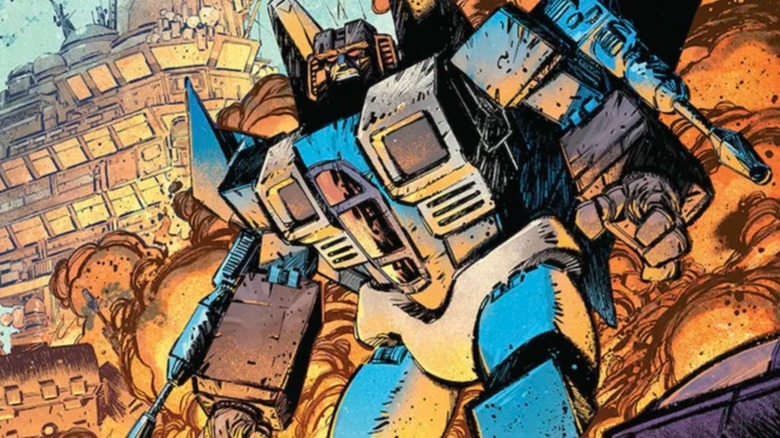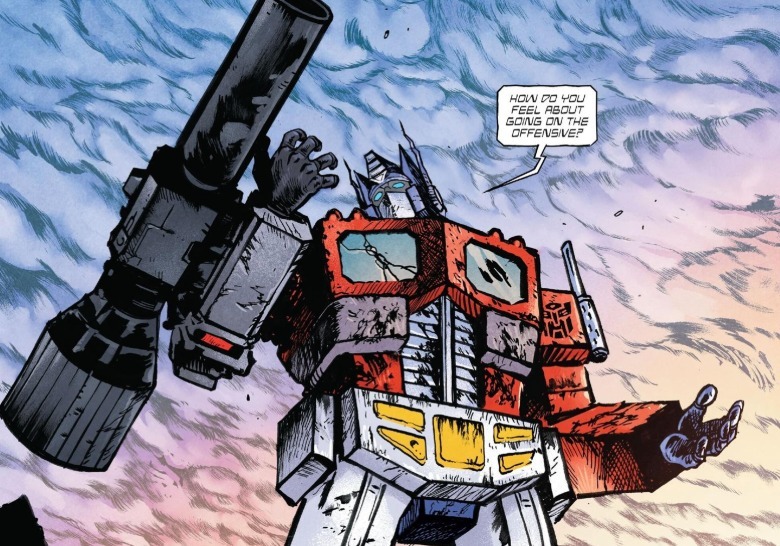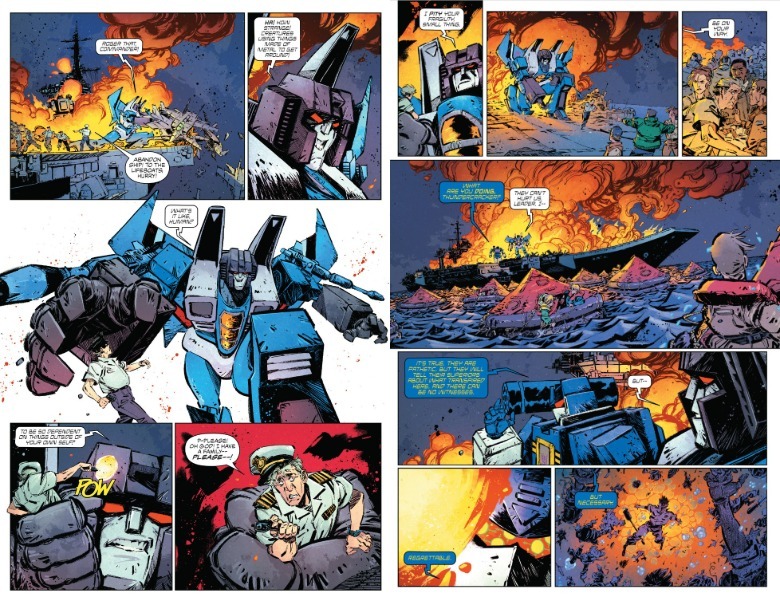How Transformers Finally Achieved A Decepticon Redemption Arc Four Decades In The Making
We may receive a commission on purchases made from links.
Daniel Warren Johnson ended his "Transformers" run at issue #24 by leaving a few plot threads open. One concerned the fate of the Decepticon Thundercracker. Ever since being reactivated in issue #5, Thundercracker had been growing disillusioned with the Decepticons and them massacring "pitiful" beings like humans. In issue #16, he abandoned the 'Cons when he learned Starscream and Soundwave revived him by tearing apart his injured friend Skywarp for spare parts.
Thundercracker resolved to find a way to fix Skywarp. New "Transformers" writer Robert Kirkman has delivered that: In issue #26, the Autobots extend a helping hand. Optimus Prime may be the one who defeated Skywarp originally back in issue #3, but the heroic Autobot leader is still horrified by the half-dead state that Skywarp's "brothers" left him in. Funnily enough, the reawakened Skywarp flies right back to the Decepticons and spurns Thundercracker, who declares, "I've chosen my side [with the Autobots]."
This face turn isn't unexpected, especially for longtime "Transformers" fans. Thundercracker is part of the original 1984 "Transformers" toy line and a "Seeker," aka a Decepticon jet fighter. He shares a model with Skywarp and Starscream, distinguished by their color schemes: Starscream is silver and red, Skywarp is black and purple, and Thundercracker is blue.
Thundercracker's character bio described him as proud of his ability to fly, yet also uncommitted to the Decepticons. Unlike the other Decepticons, Thundercracker pities humans. Due to peer pressure and fear of lacking a purpose should he desert, he stayed with the Cons.
Neither the original "Transformers" cartoon or the Marvel "Transformers" comic did anything with this kernel of character depth. Thundercracker and Skywarp were grunts who filled out the background and took orders from the important Decepticons. Thankfully, later writers like Johnson and Kirkman have recognized Thundercracker's untapped potential.
Thundercracker has only soared in Transformers comics
Thundercracker's marginal role in the original "Transformers" means he hasn't often been a star since; take how he never showed up in the Michael Bay "Transformers" movies. The 2002-2003 anime "Transformers: Armada" instead redeveloped Starscream into the Decepticon with doubts. Since Starscream even received a blue recolor later in the show, some fans have claimed the "Armada" Starscream is a spiritual Thundercracker.
In Thundercracker's second major animated appearance, "Transformers: Cybertron," he was a dimwitted yokel. The 2010 video game "Transformers: War For Cybertron" depicted him as a scientist and the straight man of the Seeker trio, his caution contrasting Starscream's arrogance and Skywarp's buffoonery.
The first "Transformers" story to depict Thundercracker as his original bio characterized him was a 2008 comic series: IDW Publishing's "Transformers: All Hail Megatron" by writer Shane McCarthy and artist Guido Guidi. There, the Decepticons conquer Earth, but Thundercracker grows frustrated with Megatron's brutality. In issue #12, the Decepticons try to wipe out the Autobots by dropping a nuke on New York City. Thundercracker steps forward to intercept and destroy the bomb, but he makes it clear he is not joining the Autobots: "The Decepticons are forged through combat, not slaughter," he says to justify himself.
In the later IDW "Transformers" comics (a continuity that concluded in 2018 with "Transformers: Unicron"), Thundercracker remained a Decepticon in exile. He stayed on semi-friendly terms with the Autobots, but he never actually joined them. Instead, he moved to Earth and remained neutral. Writer John Barber redeveloped the reformed Thundercracker into a comic relief character; while living on Earth, he becomes a fan of television and decides to become a screenwriter.
The "Energon Universe" Thundercracker, though, has definitively chosen the Autobots and will presumably fight against his former brothers-in-arms.
Skybound's Thundercracker has finally chosen the Autobots
Thundercracker's turn in "Transformers" #26 doesn't just develop his character; it also develops the book's hero, Optimus Prime. Optimus is a fundamentally kind individual, but war hardens kind people. Johnson's run was about Optimus trying to hold his violent side at bay. For most of it (issues #4-21), he wielded Megatron's stolen right arm and fusion cannon, which infected him with bloodthirstiness symbolically and literally.
The ethos of Optimus Prime, as defined by his original voice actor Peter Cullen on advice from his brother Larry, is: "Be strong enough to be gentle." Optimus helps Thundercracker and Skywarp because, if possible, he wants to end the war without another battle. Doing so will require that he show his enemies grace.
Prime's right hand, Ultra Magnus, distrusts Thundercracker. Optimus wants to end the war, but Magnus wants to win it. The ending shows both of them were right. Optimus' approach means the Decepticons have Skywarp back, but it also turned Thundercracker from an enemy into an ally. That assumes Thundercracker will stay with the Autobots long term, though.
Only Optimus has shown him sympathy, so far, and he's got ideological disagreements with the Autobots. While Thundercracker is not a sadist, he still believes that might makes right. Even Thundercracker's sympathy for humans comes from a place of contempt. They're small, weak, and defenseless against Transformers, and so killing them is dishonorable. See his initial reaction to them back in issue #8:
Kirkman's "Transformers" #25 showed Megatron reminding his troops that the Decepticons want peace — Peace through Tyranny. Could Megatron's skill with words put Thundercracker back under his heel, too?




